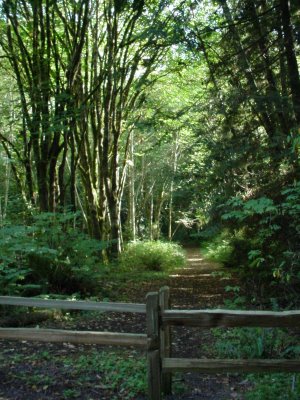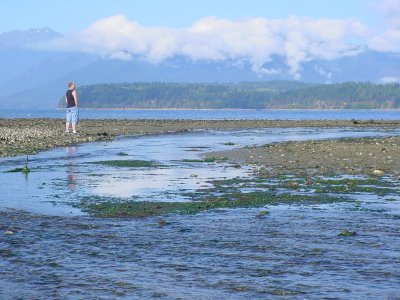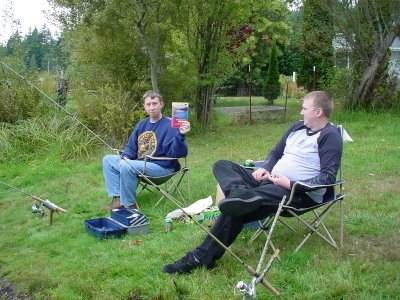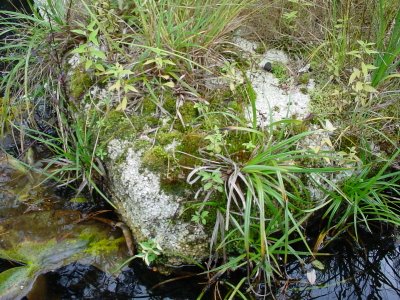 This is an algae bog in an old growth forest in Kitsap County.
This is an algae bog in an old growth forest in Kitsap County. On Saturday we hiked through this forest to get to tideflats below Anderson Landing, in Kitsap County.
On Saturday we hiked through this forest to get to tideflats below Anderson Landing, in Kitsap County. There was a 'seldom used' trail, replete with fallen leaves, mossy rocks, 5 inch slugs, and oodles of cobwebs extending from one side of the trail over to the other - and of course I led the way, brushing the thin whisps off my face as we went along. However, any spider spinning trails over 5 feet 4 inches tall lost his efforts when George walked by. He got his face full too.
There was a 'seldom used' trail, replete with fallen leaves, mossy rocks, 5 inch slugs, and oodles of cobwebs extending from one side of the trail over to the other - and of course I led the way, brushing the thin whisps off my face as we went along. However, any spider spinning trails over 5 feet 4 inches tall lost his efforts when George walked by. He got his face full too.  We hiked for about 40 minutes on a fairly steep trail down to the water, then arrived at an open area, pictured here, strewn with oysters and mussel shells. A freshwater spring emptied into this bay. Those are the Olympic Mountains in the background.
We hiked for about 40 minutes on a fairly steep trail down to the water, then arrived at an open area, pictured here, strewn with oysters and mussel shells. A freshwater spring emptied into this bay. Those are the Olympic Mountains in the background.The day started out gorgeous and sunny, perfect for hiking and exploring. When we finished, we decided to canoe Mission Lake, which is nearby. It is a little lake, with quaint cabins and nicely maintained homes. There is a fishing-boating ramp that made it easy to unload the canoe.
 This photo shows the far end of the lake, which is more remote, and boggy. Wildlife enthusiasts have placed nesting houses for large birds along the shoreline. I was surprised to see wild aquatic lobelia still in bloom, a bright yellow. A few large grey dragonflies hovered alongside us. It is uncommon to see them this time of year when it gets chilly.
This photo shows the far end of the lake, which is more remote, and boggy. Wildlife enthusiasts have placed nesting houses for large birds along the shoreline. I was surprised to see wild aquatic lobelia still in bloom, a bright yellow. A few large grey dragonflies hovered alongside us. It is uncommon to see them this time of year when it gets chilly. As George unloaded the canoe, these two fishermen told me that this was their first time fishing in Washington state. They are from Arkansas, serve in the Navy, and work on the aircraft carrier the 'John C. Stennis'. They didn't know where to fish, so they bought a book about fishing in Washington, with more than 1,600 locations featured - rivers, lakes, streams, reservoirs, estuaries, and coastal stretches open to anglers, regardless of their preferred tackle and technique. The author, Terry Rudnick "covers it all, from the fly-fishing-only steelhead streams of the Olympic Peninsula to deep-water trolling for giant sturgeon in the Columbia. Driving directions, fish species, regulations, preferred flies and lures, and fishing conditions are all covered for each body of water." One of the young men showed me the book, saying they'd been out since early morning, without much luck.
As George unloaded the canoe, these two fishermen told me that this was their first time fishing in Washington state. They are from Arkansas, serve in the Navy, and work on the aircraft carrier the 'John C. Stennis'. They didn't know where to fish, so they bought a book about fishing in Washington, with more than 1,600 locations featured - rivers, lakes, streams, reservoirs, estuaries, and coastal stretches open to anglers, regardless of their preferred tackle and technique. The author, Terry Rudnick "covers it all, from the fly-fishing-only steelhead streams of the Olympic Peninsula to deep-water trolling for giant sturgeon in the Columbia. Driving directions, fish species, regulations, preferred flies and lures, and fishing conditions are all covered for each body of water." One of the young men showed me the book, saying they'd been out since early morning, without much luck. From the shore, it is not easy to catch large fish, and lures and bait get stuck in the water. I told them about float tubes that I've seen fly fishermen use.
 The device enables the fisherman to walk further out into the water, floating as he goes along, to get a better vantage point. Nifty little pockets and rod holders are attached to the floating tubes, and there are places to hold beverages.
The device enables the fisherman to walk further out into the water, floating as he goes along, to get a better vantage point. Nifty little pockets and rod holders are attached to the floating tubes, and there are places to hold beverages.To stay completely dry, waders are used, which completely cover the legs and torso.
 These protect against hypothermia, guard the legs against abrasions, and prevent little critters, like parasites, from burrowing into the skin.
These protect against hypothermia, guard the legs against abrasions, and prevent little critters, like parasites, from burrowing into the skin.Long underwear can be used under the waders, and pocket warmers can be placed inside, near the feet. I've got these warmers in my backpack, for emergencies.
But, back to our glide: Mission Lake took about an hour of easy paddling, with little twists and turns that made it interesting.
 I like the charm of older cabins, nestled in the woods. One of the surprising features of this lake were the
I like the charm of older cabins, nestled in the woods. One of the surprising features of this lake were the  platforms, or docks, that were blown away from people's property, and were found stuck elsewhere, often left to rot unattended and unused. Little shrubs and trees protruded from between the boards and styrofoam, creating little meditations. These often become sunning platforms for Canadian geese and mallards, who frequent the area.
platforms, or docks, that were blown away from people's property, and were found stuck elsewhere, often left to rot unattended and unused. Little shrubs and trees protruded from between the boards and styrofoam, creating little meditations. These often become sunning platforms for Canadian geese and mallards, who frequent the area. This is a large piece of styrofoam stuck between submerged logs. It's a 'nurse-log' for nesting aquatic plants. Parts of this had been chewed off by beavers, who had a dam at the end of the lake. Submerged logs are always the most dangerous part of canoeing a small lake like this, and the tannins in Mission Lake made the water very dark. It was difficult to see the logs.
This is a large piece of styrofoam stuck between submerged logs. It's a 'nurse-log' for nesting aquatic plants. Parts of this had been chewed off by beavers, who had a dam at the end of the lake. Submerged logs are always the most dangerous part of canoeing a small lake like this, and the tannins in Mission Lake made the water very dark. It was difficult to see the logs.Our paddle was quite delightful, and was a refreshing way to end the day.